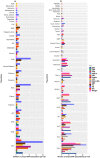Genome-wide landscape establishes novel association signals for metabolic traits in the Arab population
- PMID: 32902719
- PMCID: PMC7889551
- DOI: 10.1007/s00439-020-02222-7
Genome-wide landscape establishes novel association signals for metabolic traits in the Arab population
Abstract
While the Arabian population has a high prevalence of metabolic disorders, it has not been included in global studies that identify genetic risk loci for metabolic traits. Determining the transferability of such largely Euro-centric established risk loci is essential to transfer the research tools/resources, and drug targets generated by global studies to a broad range of ethnic populations. Further, consideration of populations such as Arabs, that are characterized by consanguinity and a high level of inbreeding, can lead to identification of novel risk loci. We imputed published GWAS data from two Kuwaiti Arab cohorts (n = 1434 and 1298) to the 1000 Genomes Project haplotypes and performed meta-analysis for associations with 13 metabolic traits. We compared the observed association signals with those established for metabolic traits. Our study highlighted 70 variants from 9 different genes, some of which have established links to metabolic disorders. By relaxing the genome-wide significance threshold, we identified 'novel' risk variants from 11 genes for metabolic traits. Many novel risk variant association signals were observed at or borderline to genome-wide significance. Furthermore, 349 previously established variants from 187 genes were validated in our study. Pleiotropic effect of risk variants on multiple metabolic traits were observed. Fine-mapping illuminated rs7838666/CSMD1 rs1864163/CETP and rs112861901/[INTS10,LPL] as candidate causal variants influencing fasting plasma glucose and high-density lipoprotein levels. Computational functional analysis identified a variety of gene regulatory signals around several variants. This study enlarges the population ancestry diversity of available GWAS and elucidates new variants in an ethnic group burdened with metabolic disorders.
Conflict of interest statement
The authors affirm that there is no conflict of interest to declare.
Figures





Similar articles
-
Generalizability of GWA-Identified Genetic Risk Variants for Metabolic Traits to Populations from the Arabian Peninsula.Genes (Basel). 2021 Oct 18;12(10):1637. doi: 10.3390/genes12101637. Genes (Basel). 2021. PMID: 34681031 Free PMC article. Review.
-
Genetic risk variants for metabolic traits in Arab populations.Sci Rep. 2017 Jan 20;7:40988. doi: 10.1038/srep40988. Sci Rep. 2017. PMID: 28106113 Free PMC article.
-
Genome-wide association study identifies novel risk variants from RPS6KA1, CADPS, VARS, and DHX58 for fasting plasma glucose in Arab population.Sci Rep. 2020 Jan 13;10(1):152. doi: 10.1038/s41598-019-57072-9. Sci Rep. 2020. PMID: 31932636 Free PMC article.
-
A Multinational Arab Genome-Wide Association Study Identifies New Genetic Associations for Rheumatoid Arthritis.Arthritis Rheumatol. 2017 May;69(5):976-985. doi: 10.1002/art.40051. Epub 2017 Mar 31. Arthritis Rheumatol. 2017. PMID: 28118524
-
Gaining insight into metabolic diseases from human genetic discoveries.Trends Genet. 2021 Dec;37(12):1081-1094. doi: 10.1016/j.tig.2021.07.005. Epub 2021 Jul 24. Trends Genet. 2021. PMID: 34315631 Free PMC article. Review.
Cited by
-
ANGPTL3 Variants Associate with Lower Levels of Irisin and C-Peptide in a Cohort of Arab Individuals.Genes (Basel). 2021 May 17;12(5):755. doi: 10.3390/genes12050755. Genes (Basel). 2021. PMID: 34067751 Free PMC article.
-
Metabolic diversity in human populations and correlation with genetic and ancestral geographic distances.Mol Genet Metab. 2022 Nov;137(3):292-300. doi: 10.1016/j.ymgme.2022.10.002. Epub 2022 Oct 13. Mol Genet Metab. 2022. PMID: 36252453 Free PMC article.
-
GWAS in people of Middle Eastern descent reveals a locus protective of kidney function-a cross-sectional study.BMC Med. 2022 Mar 1;20(1):76. doi: 10.1186/s12916-022-02267-7. BMC Med. 2022. PMID: 35227251 Free PMC article.
-
Genome-wide associations with metabolic syndrome among UK Biobank participants reporting use of second-generation antipsychotics.Pharmacotherapy. 2025 Aug;45(8):476-485. doi: 10.1002/phar.70041. Epub 2025 Aug 5. Pharmacotherapy. 2025. PMID: 40762455 Free PMC article.
-
Generalizability of GWA-Identified Genetic Risk Variants for Metabolic Traits to Populations from the Arabian Peninsula.Genes (Basel). 2021 Oct 18;12(10):1637. doi: 10.3390/genes12101637. Genes (Basel). 2021. PMID: 34681031 Free PMC article. Review.
References
-
- Adeyemo A, Bentley AR, Meilleur KG, Doumatey AP, Chen G, Zhou J, Shriner D, Huang H, Herbert A, Gerry NP, Christman MF, Rotimi CN. Transferability and fine mapping of genome-wide associated loci for lipids in African Americans. BMC Med Genet. 2012;13:88. doi: 10.1186/1471-2350-13-88. - DOI - PMC - PubMed
MeSH terms
LinkOut - more resources
Full Text Sources
Medical

